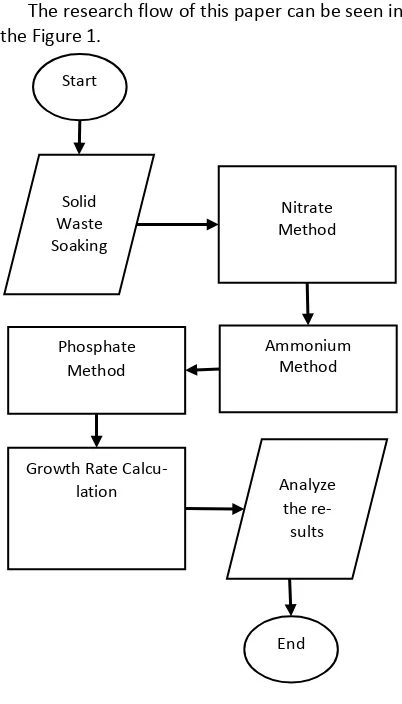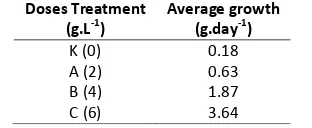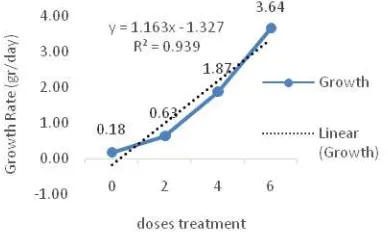A Solid Waste Pond Tiger Shrimp (Peneaus monodon) as Fertilizer for
Caulerpa lentillifera
Nyoman Robby Manik Saputra
1*, Sukoso
2, Hartati Kartikaningsih
21
Master Program of Aquaculture, Faculty of Fisheries and Marine Sciences, University of Brawijaya, Malang, Indonesia
2
Faculty of Fisheries and Marine Sciences, University of Brawijaya, Malang, Indonesia
Abstract
Farming the shrimp, fish and another comodity could produce large quantities of waste. Aquaculture waste can be formed as feces, residual feed and dead organism which are accumulated in a cultivation area. Generally, the waste is discharged directly into the water without filtration. Thus, one of problems that are often faced by farmer is the low quality of pure water due to the high content of nutrients. Moreover, suspended solid pollutant will be formed that lead to eutrophication, oxygen depletion, and precipitation. The aim of this research is to analyze the solid waste pond tiger shrimp as fertilizer for the growth of Caulerpa lentiilifera. Here, the Random Design complete (RAL) and three times in Deuteronomy are used in the experiment. The parameters of one control and three treatment doses are used 0, 2, 4, and 6 g.L-1 respectively. The results showed that solid waste shrimp ponds can be used as fertilizer to meet the needs of
Caulerpa lentillifera for growth and the results show the highest value is found in the dose of 6 g.L-1 with NO3
(4.58 ppm), NH4
+
(3.34 ppm), PO4
(2.03 ppm) and the value of the rate of growth and the PH are obtained (3.64 g.day-1) and (6,4-8), respectively.
Keywords:Caulerpa lentillifera, growth rate, Nitrification, solid waste, Tiger Shrimp.
INTRODUCTION
Aquaculture waste is waste generated from a shrimp or fish farming that can cause pollution in the aquatic environment if not immediately addressed. Cultivation of waste could be remnants of the digestion of fish or shrimp or leftover feed that settles on the bottom. The amount of waste goes to the water is linear to the production obtained. The waste could cause environmental problems, related to the magnitude of the amount of nitrogen (N) and phosphorus (P) which are dumped into waterways [1]. For instance, farmed shrimp in Australia estimate the amount of N and P produced was 290 and 16 kg.ha-1year-1. Whereas farmed shrimp in California estimate the amount of N and P produced amounted to 112 and 32 kg.ha-1year-1 [2]. While the amount in Indonesia, N and P produced from intensive and traditional ponds reached 399 and 37 kg.ha-1year-1 [3].
To overcome this problem, this research fo-cused on making a fertilizer using the solid waste of shrimp. Since the solid waste ponds of shrimp contains 1.92% organic C, 0.54% N total, and 1.70% P [4]. Moreover, the solid waste can be used by plants to grow as organic fertilizer, since
Correspondence author: Nyoman Robby Manik Saputra Email : roby.manik.sc@gmail.com
Address : Faculty of Fisheries and Marine Sciences, University of Brawijaya, Jl. Veteran Malang, 65145
plants need NH4 +
and NH3 -
amino acid in the formation. In his role as fertilizer, solid waste ponds shrimp will be used for cultivating
Caulerpa lentiilifera.
Caulerpa lentiilifera is often called the sea grape is a type of seaweed green (Chlorophyta) that can survive in environments that have high pollution levels [5]. Cultivation of C. lentillifera
has started developing in indonesia, because it can be eaten fresh and also it rich of nutrients that are good for the human body. This sea grape type can also be used as ingredients in cosmetics and pharmaceuticals. In addition, Sea grape types of C. lentillifera are highly favored by some countries such as Japan, Australia, and Fillipina [6].
The idea of this research is based on nitrification process. Nitrification is the process by which ammonia is converted to nitrites and then nitrates by the assistance of Nitrosomonas
gas [9]. Formation of nitrogen gas is considered negligible in pond aquaculture [10]. The bacteria present in the water and sediment to transform nitrogen through nitrification and denitrification [11]. Thus, this study aims to grow C. lentillifera
by analyzing the content of nitrate, ammonium and phosphate in solid waste of tiger shrimp pond (Peneaus monodon) to be used as fertilizer.
MATERIALS AND METHODS
The research flow of this paper can be seen in the Figure 1.
Figure 1. The research flow
Solid Waste Soaking
Solid wastes were obtained from BBPBAP (Balai Besar Perikanan Budidaya Air Payau) Jepara. The waste was taken at the time of recirculation process in the ponds by using Multi Cylone 16. Then, the waste was dried. After that, the dried solid waste was weighed according to the dosage that will be used in this research, which are 0 g.L-1, 2 g.L-1, 4 g.L-1, and 6 g.L-1. Administration of doses [12] has been modified.
Waste that had already been weighed would be soaked in the controlled tub (aquarium) that already contained sea water, then it was left for
48 hours to observe the content of nitrification [4].
Nitrate Method
The method of Nitrate analysis was appropriate [13], 12.5 mL water samples were taken and put in a porcelain cup. The sample waters were heated using hot plate until the crust appeared on the porcelain cup. Fenoldisulfonik acid solution of 1 ml were added to the crusted porcelain cup. After that, 2 ml of distilled waters were added into a porcelain cup and then the crust on a porcelain plate was scraped with a spatula. NH4OH solution was added to the porcelain cup until the crust turned into stable yellow, next the distilled waters were added into the porcelain cup until volume reached 12.5 mL (initial volume). The samples were poured into cuvettes then and nitrate concentration was measured by UV Visible with a wavelength of 410 nm [14].
Ammonium Method
Methods of analysis in accordance with ammonium SNI 06-2479-1991 use the following steps. Water samples taken as much as 12.5 mL and put into a beaker glass 50 mL. Solution of 0.5 ml Nessler as much added to in a beaker glass, a beaker glass then is shaking in order to make the perfect solution and let sit for approximately 30 minutes. A sample cuvet is then inserted into the measure by using UV Visible Spectrophotometer with a wavelength of 425 nm [15].
Phosphate Method
Phosphate levels can be calculated in spectrophotometry, the steps undertaken in this analysis is the water sample taken approximately 50 mL and then inserted into a beaker glass. Added 1 drop indicator phenolftalin (in case of change of color to pink, then added H2SO4 drop
by drop until the color is gone). Added 0.5 gram K2S2O8 and boiled on top of the hot plate until
the remaining volume ± 10 mL. Samples are cooled and diluted with aquades up to volume 30 ml. Next, added 1 drop indicator phenolftalin and neutralized with NaOH to pink color is shown. Again, melted H2SO4 until the pink color is
vanished, then diluted to 100 mL. Furthremore, 50 mL of volume is takken into a measuring flask. Moreover, added 8 ml reactant combination, and then wait only for 15 minutes. Finally, the sample is inserted into its absorbance and measured with cuvet spectrophotometer with a wavelength of 880 nm [16].
Start
Solid Waste Soaking
Nitrate Method
Ammonium Method Phosphate
Method
Growth Rate
Calcu-lation Analyze
the re-sults
Growth Rate Calculation
Analyze the life data using variance (ANOVA). The analysis was used to examine the effect of treatment, followed by the smallest real difference test (BNT) at the 5% test level.
RESULT AND DISCUSSION
Table 1. Nitrate, Ammonium and Phosphate Content (ppm) on different content decomposition of organic substances were C/N ratio, pH, temperature and DO [18]. Comparison of Nitrate content, Ammonium and Phosphate is the basis of water quality, where the highest Nitrate value reaches 4.58 ppm. Comparing with standard quality of water quality, it is classified as polluted, because the tolerance limit of nitrate value in pond is not more than 0.5 ppm [19]. Nitrogen in seawater consists of various compounds, but there are only three compounds containing toxic for fish and other organisms, nutrient for growth C. lentillifera [21].
Here, the value of ammonium with the largest value of 3.34 ppm is obtained. It is a very good value for growth Caulerpa lentillifera. Because ammonium is needed for the process of protein formation in plants, ammonium serves as a support when plants lack N elements in the water. This ammonium is classified as a form of ammonium nitrogen [22]. Absorption of nitrogen by plants can be almost entirely in the form of ammonium or nitrate. Ammonium is used to be the main source for the growth in agriculture and most of the natural environment.
Meanwhile, the value of phosphat with the highest value of 2.03 ppm is observed. This means water has a very high fertility rate, because waters with high fertility levels have phosphate levels of 0.51-1 ppm, medium fertility levels have levels of phosphate 0.2-0.5 ppm and a low fertility rate of 0-0.2 ppm. The main function of the phosphate element is to accelerate the growth of the root semia, accelerate and strengthen the growth of young plants into adulthood, accelerate flowering and ripening and increase seed production [23].
Growth Rate of Caulerpa lentillifera
The results obtained by the heavy growth of where the nutrient (Table 1) produced is greater than the other treatments resulting in an average daily growth 3.64 g.day-1. Whereas in the treat-ment K only 0.18 g.day-1. Therefore, the greatest growth obtained in the treatment of C which is needed more than other treatments.
Figure 2. Growth Rate of Caulerpa lentillifera
Figure 2 shows the daily growth rate of C. lentillifera using various doses treatments. This can be proved that the difference of doses of solid waste ponds shrimp produces various growth rates of seedlings of sea grape (Fig. 2). Here, the higher dosage gives the growth rate increasing. Moreover, use the regression the function is obtained , where and denote the growth rate func-tions and doses treatment respectively.
pH Water
Based on the observations that have been made during the study, the range of the pH is 6.4
– 8. The degree of acidity is good for the growth of algae is between 6-9 with optimal range 6.3-8.2 [25]. This condition describes that any algae have different torelansi towards a pH. According to [26] States that the increase in pH values will affect the lives of algae and aquatic tendencies have a high acidity level due to the entry of large quantities of organic waste. The number of nitrification is very closely related to the pH levels. The longer soaking nitrates will soften that also comes with a decrease in pH. PH changes depending on the process of amonifikasi and nitrification of nitrogen into ammonium and nitrate. The reaction of nitrate formation will free H+ resulting pH in being dropped [27].
CONCLUSION
The results showed that solid waste shrimp ponds can be used as fertilizer to meet the needs of C. lentillifera for growth. Where nutrient obtained from the immersion of nitrate, ammo-nium and phosphate in the treatment with a doses of 6 g.L-1 has a good value to grow C. lentillifera.
REFERENCES
[1] Siti, D., Nancy, H. Budiastuti. 2008. Absorpsi polutan amoniak di dalam air tanah dengan memanfaatkan tanaman Eceng Gondok
(Eichornia crassi). Jurnal Spektrum Teknolo-gi. 15(2).
[2] Lacerda, L.D., A.G. Vaisman, L.P. Maia, C.A.R. de Silva, E.M.S. Cunha. 2006. Relative importance of nitrogen and phosphorus emmisions from shrimp farming and other anthropogenic sources of six estuaries along the NE Brazilian coast. Aquaculture. 253. 433-446.
[3] Nur, A. 2011. Manajemen pemeliharaan Udang Vaname. General Directorate of Fi-sheries Culture, BBPBAP Jepara. Center of Fisheries and Marines. Jakarta.
[4] Tangguda, S., A. Diana, W.E. Arning. 2015. Utiliation of solid waste from White Shrimp (Litopenaeus vannamei) farm on the growth and Chlorophyll content in Chlorella sp. J. Life Sci. Biomed. 5(3). 81-85.
[5] Paul, N.A., dN. Rocky. 2008. Promise and pitfalls of locally abundant seaweeds as
biofilters for integrated aquaculture. Jurnal Aquaculture. 281. 49-55.
[6] Hanafi, A. 2007. Teknik produksi anggur laut
Caulerpa lentillifera. Proceeding of National Symposium of Research Results on Marine and Fisheries. Indonesian Institute of Science (LIPI). Jakarta. 12-15.
[7] Badjoeri, M., Lukman. 2010. Distribusi dan kelimpahan populasi bakteri hetrotrofik di Danau Toba. Limnologi. 41. 88-97.
[8] Crab, R., Y. Avnimelech, T. Defoirdt, P. Bossier, W. Verstraete. 2007. Nitrogen removal techniques in aquaculture for a sustainable production. Aquaculture. 270. 1-14.
[9] Utomo, N.B.P., Winarti, A. Erlina. 2005. Pertumbuhan Spirulina platensis yang dikultur dengan pupuk inorganik (Urea, TSP, dan ZA) dan kotoran ayam. Jurnal Akuakultur Indonesia. 4(1). 41-48.
[10] Siswanto, D., I. Mustofa, G. Ekowati, M. Imam, E. Purnomo. 2011. Biosistem pertanian apel lokal Malang. J. Exp. Life Sci.
1(2). 56-110.
[11] Nugroho, Y.A., Y. Sugito, L. Agustina, Soemarno. 2013. Kajian penambahan dosis beberapa pupuk hijau dan pengaruhnya terhadap pertumbuhan tanaman Selada (Lactuca sativa L). J. Exp. Life Sci. 3(2). 45-53.
[12] Guo, H., J. Yao, Z. Sun, D. Duan. 2014. Effects of salinity and nutrients on the growth and chlorophyll fluorescence of
[13] Boyd, C.E. 1986. Water quality management for pond fish culture. Elselvier Scientific Publishing Company. Amsterdam.
[14] Kjeldahl, J. 1883. A new method for the estimation of nitrogen in organic compounds. Z. Anal. Chem. 22. 366-372. [15] BSN. 1991. Air, metode pengujian kadar
amonium dengan alat spektrofotometer secara Nessler, SNI-06-2479-1991. Nationa Standard Office. Jakarta.
[16] Olsen, S.R., C.V. Cole, F.S. Watanabe, L.A. Dean. 1954. Estimation of available phosphorus in soils by extraction with sodium bicarbonate. US Government Printing Office. Washington DC.
[17] Effendie, M.I. 1997. Biologi perikanan. Yayasan Pustaka Nusantara. Yogyakarta. [18] Yuningsih, H.D., P. Soedarsono, S. Anggoro.
2014. Hubungan bahan organik dengan produktivitas perairan pada kawasan tutupan eceng gondok, perairan terbuka dan keramba jaring apung di Rawa Pening Kabupaten Semarang Jawa Tengah.
Diponegoro Journal of Maquares. 3(1). 37-43.
[19] Undu, M.C., Makmur, S. Rachman. 2014. Studi pendahuluan laju efflux nutrien sedimen di tambak udang Litopenaeus vannamei super intensif. Proceeding of Forum on Aquaculture Technology Innova-tion 2014.
[20] Manikandan, K, T. Viruthagiri. 2010. Optimization of C/N ratio of the medium and Fermentation conditions of Ethanol Production from Tapioca Starch using Co – Culture of Aspergillus niger and Sachormyces cerevisiae. Int. J. ChemTech Res. 2(2). 947-955.
[21] Paul, N., A.N. Neveux., M. Magnusson, R.D. Nys. 2013. Comparative production and
nutritional value of “sea grapes” — the tropical green seaweeds Caulerpa lentillifera and C. racemosa. J. Appl. Phycol.
DOI 10.1007/s10811-013-0227-9.
[22] Howitt, S.M., M.K. Udvardi. 2000. Structure, function and regulation of ammonium transporters in plants. Biochimica et Biophysica Acta (BBA)-Biomembranes.
1465(1-2). 152-170.
[23] Fahrur, M., Makmur, C.U. Muhammad. 2014. Konsentrasi nitrogen terlarut dan fosfat dalam tambak Udang Vaname (Litopenaeus vannamei) sistem super intensif. Proceeding of Forum on Aquacul-ture Technology Innovation 2014.
[24] Carpenter, E.J., Capone, D.G. 1983. Nitrogen in the marine environment. Academic Press. 574.52636 900 p.
[25] Syahputra, Y. 2005. Pertumbuhan dan kandungan karaginan Budidaya Rumput Laut Eucheuma cattonii pada Kondisi Lingkungan yang Berbeda dan Perlakuan Jarak Tanam di Teluk Lhok Seudu. Master Thesis. Graduate School, Bogor Agricultural University. Bogor.
[26] Luning, K. 1990. Seaweed: their environment, biogeography and ecophysio-logy. Jhon Wiley & Sons, Inc. New York. [27] Nainggolan, G.D., Suwardi, Darmawan.


